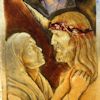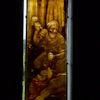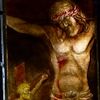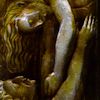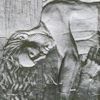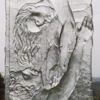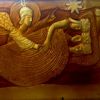ENCOMPASSART STUDIO
-ARCHITECTURAL ARTISTS
The Stations of the Cross Panels - Kericho Cathedral
These are the stations of the cross panels
Stations of the Cross
At the time we were thinking about the doors, we were considering making them also as glass relief sculpted panels. However I managed to find a studio capable of casting them in bronze. The methods that I had started in Northlands, and then developed at the Derix Studio, were to come to fruition in Kenya. Following the Kenyatta University debacle, we imported a glass kiln large and powerful enough to fuse these panels. We also imported Bullseye glass and frit. So began this great challenge of making such works in Kenya.
The basic materials are hard to find. The power supply us erratic. There is an issue, disputed, that firing at altitude makes a difference to the firing schedule and many other issues that making such works a serious challenge in Kenya. However, at the time of writing this, the final piece is firing.
During the process of working on the stations for the Cathedral interior, we were asked to produce a set for the exterior also. We decided to use the same moulds that we had created for the internal panels, but to create positive relief sculptures using float glass which was sandblasted.
Florence made the original sculptures using clay. Even finding clay of a suitable quality was an adventure in Nairobi. However, with perseverance, we found someone who could make some and deliver it.
We cast the sculptures using Vinamould, a re-meltable silicone compound. From these moulds, we could either create a positive form that when suitably dried, we could place in the kiln, add coloured frit, and lay pre-fired 19mm glass on top, fusing all together. The total length of a firing of this type is approximately 10 days. During this time, the kiln must have a constant supply of mains electricity or generator produced electricity. This has proved to be a major problem here with many firings plagued by power and generator failures.
We should have made 48 moulds. 3times 14, the number of the Stations of the Cross. A set of positive moulds for the internal stations, a set of negative moulds made with wax, for the external stations, and a set of 14 concrete moulds that we could recast in the event of the need to re-fire. It is a blessing that we made these concrete panels. Due to breakages and disasters during the firing process, we probably made nearer 80 moulds.
The moulds for firing in the kiln were made using very expensive locally sourced silica sand, straight from the river bed or sand pit. We have to sieve all sorts of foreign bodies from the sand before we can use it. We have had multiple issues of the Plaster of Paris being faulty and ruining a pour. However, thanks to the tenacity of the team and the patience and understanding of the donors, this incredibly difficult but beautiful project, is coming to an end.
making a station of the cross
The film shows the Artist Florence Wangui and myself with the help of Patrick Kamau going through the various stages of creating this one panel, nr. 14, the last in the cycle of the Stations of the Cross for Kericho Cathedral.
AS can be seen in this film, this is not glass painting, but a relief sculpture.




